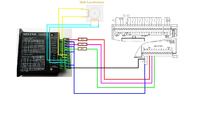As I do not have an application note for the controller and I am connecting it for the first time, please help if my preview drawing is correct:

1. Resistors limit the voltage from 24V to 5V. Which I do not know yet, because I do not know what current the input consumes. I will connect the power supply to the 5V output and measure the current and choose a resistor this way.
2. The engine will be powered from 12V but it's not a problem, the converter will take care of the problem.
3. Control from PLC is PTO or PWM?

1. Resistors limit the voltage from 24V to 5V. Which I do not know yet, because I do not know what current the input consumes. I will connect the power supply to the 5V output and measure the current and choose a resistor this way.
2. The engine will be powered from 12V but it's not a problem, the converter will take care of the problem.
3. Control from PLC is PTO or PWM?


